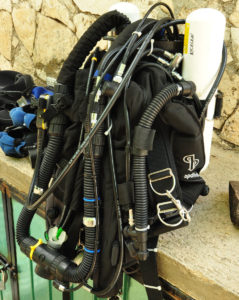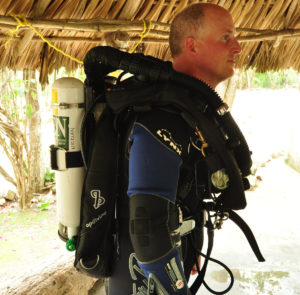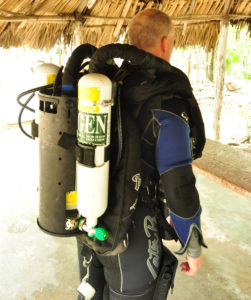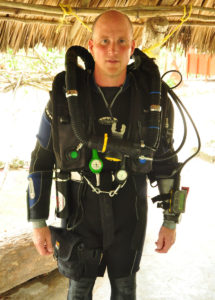Deep sinkhole photo shoot preparation Part I – Modifying a brand new Rebreather for cave diving means being drastic and chop chop your new baby.
Again I am working on a CCR cave diver training program. This time it is Paul Nicklen, a award winning National Geographic photographer who is renown for his Arctic wild life photography.
Paul contacted me to get trained to the CCR cave diver level in order to shoot a National Geographic assignment in a Central Yucatan sinkhole. Most sinkholes are openwater dives but due to depth, decomposing material at the bottom that can be stirred up easily and the potential rock overhead they should be treated as cave dives in particular when it comes to zero visibility related drills and skills.
When Paul arrived we took his brand spanking new AP Diving Evolution Rebreather out of the box and modified it for cave diving. The biggest challenge and changes are related to the fact that the cave cave diver needs to be horizontal in the water column and Rebreathers are notorious for not wanting to be horizontal in the water.
The first step was to transplant the units internals from the yellow box into a Tec frame tube allowing easy access and the attachment of larger 3 ltr steel tanks. A stainless steel back plate was added to streamline the original harness, centralize mass and move the unit higher up on Paul’s back while drilling new holes into the back plate.
A small weight was added high on top of the left diluent tank to further force Paul into the horizontal and counter balance the left hand side bailout tank.
Further modifications are the larger Inspiration scrubber canister prolonging bottom time from Evolution 2 hours to Inspiration 3 hours and turning the Evolution Plus into a Inspiration. A AP Diving BOV – Bail Out Valve was added to allow the diver to get off loop even under severe Hypercapnia conditions. Inline shut off valves where added to be able to isolate the ADV – Automatic Diluent Valve and BOV in order to isolate them quickly should a free flow or leak occur facilitating the internal and external boom scenario drills and skills.
The first day and a half where spend to assemble and modify the Rebreather into a kick ass cave diving machine. Putting the Rebreather onto Paul’s back, taking it off, modifying smaller or larger details, putting it back on.
Once we got to the water diving at Casa Cenote – Cenote Manati Paul had no trouble at all to get into the horizontal position by default. The time we spend modifying the unit was well worth the effort as the outcome of immediate horizontal comfortable trim was great to see and watch.
As we went through a refresher of Rebreather related emergency drills such as the Hyperoxic, Hypoxic, Hypercapnia, Boom scenario, partially and complete food recovery drills it became apparent how we transformed the basic Evolution Rebreather into a stable cave diving platform getting Paul ready to receive his Rebreather cave diver training program.
The ccr cave diver program where taught and supported out of ProTec Playa . The following ccr trimix diver training program where taught and supported out of ProTec Tulum.
Stay tuned for Part II




